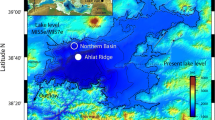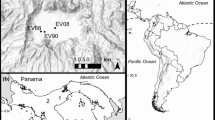Abstract
A 12 m sediment core recovered from the south basin of Lake Turkana, northwestern Kenya, reveals four major diatom assemblages that span approximately 5450 to 1070 years BP based on AMS radiocarbon analyses. The oldest assemblage, Zone D (5450 to 4850 yr BP), is dominated by Melosira nyassensis and Stephanodiscus spp. and is interpreted to reflect higher lake levels, fresher water and more variable seasonal mixing of the water column than the modern lake. Melosira dominates the assemblage in Zone C (4850 to 3900 yr BP) with some Surirella engleri and Stephanodiscus. This assemblage indicates a continuation of relatively high lake levels and seasonal mixing of a stratified lake. The brief peak of Surirella, interpreted as benthic, suggests an episode of slightly lower lake level. Thalassiosira rudolfi and Surirella predominate since the beginning of Zone B (3900 to 1900 yr BP), reflecting a decrease in lake level and increase in water column salinity. Increasing dominance of Surirella in Zone A (1900 to 1070 yr BP) may suggest that the lake continued to decrease in depth. Salinity probably rose to levels comparable with the modern lake. These results are consistent with paleoclimatic interpretations based on carbonate abundance, lamination thickness, oxygen isotope and bulk geochemistry profiles from this core and cores recovered from the north basin. It extends the known paleolimnology beyond 4000 yr BP of the earlier research to 5450 yr BP and into the early to mid Holocene pluvial phase in northern intertropical east Africa.
Similar content being viewed by others
References
Barton, C. E. & T. Torgersen, 1988. Palaeomagnetic and 210Pb Estimates of sedimentation in Lake Turkana, East Africa. Palaeogeogr. Palaeoclim. Palaeoecol. 68: 53–60.
Butzer, K. W., G. L. Issac, J. L. Richardson & C. Washburn-Kamau. 1972. Radiocarbon dating of East African Lake Levels. Science 175: 1069–1076.
Cerling, T. E., J. R. Bowman & J. R. O'Neil, 1988. An isotopic study of a fluvial-lacustrine sequence: The Plio-Pleistocene Koobi Fora sequence, East Africa. Palaeogeogr. Palaeoclim. Palaeoecol. 63: 335–356.
COHMAP Members, 1988. Climatic changes of the last 18000 years: Observations and model simulations. Science 241: 1043–1052.
Ferguson, A. D. J. & B. J. Harbott, 1982. Geographical, physical and chemical aspects of Lake Turkana. In: Hopsen, A. J. (ed), Lake Turkana: A Report of on the Findings of the Lake Turkana Project, 1972–1975. Overseas Development Administration, London. p. 1–107.
Finney, B. P., J. D. Halfman & T. C. Johnson, submitted. Controls on detrital sediment sources in an arid rift-valley lake, Lake Turkana, Kenya. 22 ms pp., 4 tab., 8 fig. Submitted to Quat. Res., May 1991.
Gasse, F., 1980. Les diatomees lacustres Plio-Pleistocenes du Gadeb (Ethiopie). Rev. Algol. Mem. Ser. 3: 249 pp.
Gasse, F., 1986. East African Diatoms: Taxonomy, Ecological Distribution. Bibliotheca Diatomol. #11, Cramer, Stuttgart.
Gasse, F., J. F. Talling & P. Kilham, 1983. Diatom assemblages in East Africa: classification, distribution and ecology. Revue Hydrobiol. trop. 16: 3–34.
Haberyan, K. A., 1987. Fossil diatoms and the history of Lake Rukwa, Tanzania. Freshwat. Biol. 17: 429–436.
Haberyan, K. A. & R. E. Hecky, 1987. The late Pleistocene and Holocene stratigraphy and paleoclimatology of Lakes Kivu and Tanganyika. Palaeogeogr. Palaeoclim. Palaeoecol. 61: 169–197.
Haberyan, K. A. & O. K. Mhone, 1991. Algal communities near Cape Maclear, southern Lake Malawi. Hydrobiologia. 215: 175–188.
Halfman, J. D., 1987. High-resolution sedimentology and paleoclimatology of Lake Turkana, Kenya. Ph.D. Dissertation, Duke University, Durham, NC 188 pp.
Halfman, J. D. & T. C. Johnson, 1988. High-resolution record of cyclic climatic change during the past 4 ka from Lake Turkana, Kenya. Geology 16: 496–500.
Halfman, J. D., T. C. Johnson, W. J. Showers & G. S. Lister, 1989. Authigenic low-Mg calcite in Lake Turkana, Kenya. J African Earth Sci. 8: 533–540.
Halfman, J. D. & P. J. Hearty, 1990. Cyclical sedimentation in Lake Turkana, Kenya. In Katz, B. (ed), Lacustrine Basin Exploration: Case Studies and Modern Analogs, AAPG Memoir #50, Tulsa.
Hamilton, A. C., 1982. Environmental History of East Africa. Academic Press, New York. 328 pp.
Harbott, B. J., 1982. Studies on algal dynamics and primary productivity in Lake Turkana. In: Hopsen, A. J. (ed), Lake Turkana: A Report of on the Findings of the Lake Turkana Project, 1972–1975. Overseas Development Administration, London. p. 108–161.
Hecky, R. E. & H. J. Kling, 1987. Phytoplankton ecology of the great lakes in the rift valleys of Central Africa. Arch. Hydrobiol. 25: 197–228.
Hustedt, F., 1930. Bacillariphyta. In: Pashcer, A. (ed), Die Susswasser-flora Mitteleuropas, hft. 10. Fischer, Jena.
Hustedt, F., 1949. Susswasser diatomeen. In: Exploration du Parc National Albert, Mission 2, 1935–36, fasc. 8. Institute des Parcs Nationaux du Congo belge, Brussels. 199 pp.
Johnson, T. C., J. D. Halfman, B. R. Rosendahl & G. S. Lister, 1987. Climatic and tectonic effects on sedimentation in a rift-valley lake: Evidence from Lake Turkana, Kenya. Geol. Soc. Amer. Bull. 98: 439–447.
Johnson, T. C., J. D. Halfman & W. J. Showers, 1991. Paleoclimate of the past 4000 years at Lake Turkana, Kenya based on isotopic composition of authigenic calcite. Palaeogeogr. Palaeoclim. Palaeoecol. 85: 189–198.
Kilham, P., 1971. A hypothesis concerning silica and the freshwater planktonic diatoms. Limnol. Oceanogr. 16: 10–18.
Kutzbach, J. E. & F. A. Street-Perrott, 1985. Milankovitch forcing of fluctuations in the level of tropical lakes from 18 to 0 kyr BP. Nature 317: 130–134.
Lund, J. W. G., 1955. Further observations on the seasonal cycle of Melosira italica subsp. subarctica O. Mull. J. Ecol. 43: 90–103.
Owen, R. B., J. W. Barthelme, R. W. Renant & A. Vincens, 1982. Palaeolimnology and archaeology of Holocene deposits north-east of Lake Turkana, Kenya. Nature 298: 523–528.
Pachur, H.-J. & P. Hoelzmann, 1991. Paleoclimatic implications of late Quaternary lacustrine sediments in western Nubia, Sudan. Quat. Res. 36: 257–276.
Richardson, J. L., 1964. Plankton and fossil plankton studies on certain East African lakes. Verh. int. Ver. Limnol. 15: 993–999.
Richardson, J. L., 1968. Diatoms and lake typology in East and Central Africa. Int. Revue Gesamten Hydrobiol. 53: 299–338.
Richardson, J. L., T. J. Harvey & S. A. Holdship, 1978. Diatoms in the history of shallow East African lakes. Pol. Arch. Hydrobiol. 25: 341–353.
Round, F. E., 1961. Diatoms of a core from Esthwaite Water. New Phytol. 60: 42–59.
Stoermer, E. F. & H. Håkanson, 1983. An investigation of the morphological structure and taxonomic relationships of Stephanodiscus damasii. Hustedt. Bacillaria. 6: 245–255.
Street, F. A. & A. T. Grove, 1979. Global maps of lake-level fluctuations since 30 000 yr BP. Quat. Res. 12: 83–119.
Street-Perrott, F. A. & S. P. Harrison, 1983. Temporal variations in lake levels since 30 000 yr BP — an index of the global hydrological cycle. Geophysical Monogr. 29: 118–129.
Street-Perrott, F. A., D. S. Marchand, N. Roberts & S. P. Harrison, 1989. Global lake-level variations from 18 000 to 0 years ago: A paleoclimatic analysis. U.S. Department of Energy Report, TR046, 213 pp.
Talling, J. F., 1966. The annual cycle of stratification and phytoplankton growth in Lake Victoria (East Africa). Int. Revue Gesamten Hydrobiol. 51: 545–621.
Talling, J. F., 1969. The incidence of vertical mixing and some biological and chemical consequences in tropical African lakes. Verh. int. Ver. Limnol. 17: 998–1012.
Van Meel, L., 1954. Le phytoplancton. In Exploration hydrobiologique due Lac Tanganyika v.4(1). Institute Royal des Sciences Naturalles de Belgique, Brussels. 681 pp.
Yuretich, R. F., 1979. Modern sediments and sedimentary processes in Lake Rudolf (Lake Turkana) eastern rift valley, Kenya. Sedimentology 26: 313–331.
Yuretich, R. F., 1986. Controls on the composition of modern sediments, Lake Turkana, Kenya. In Frostick, L. E. et al. (eds), Sedimentation in the African Rifts. Geol. Soc. Spec. Pub. #25, London. p. 141–152.
Yuretich, R. F. & T. E. Cerling, 1983. Hydrogeochemistry of Lake Turkana, Kenya: Mass balance and mineral reactions in an alkaline lake. Geochem. Cosmochem. Acta 47: 1099–1109.
Author information
Authors and Affiliations
Rights and permissions
About this article
Cite this article
Halfman, J.D., Jacobson, D.F., Cannella, C.M. et al. Fossil diatoms and the mid to late holocene paleolimnology of Lake Turkana, Kenya: a reconnaissance study. J Paleolimnol 7, 23–35 (1992). https://doi.org/10.1007/BF00197029
Received:
Accepted:
Issue Date:
DOI: https://doi.org/10.1007/BF00197029




